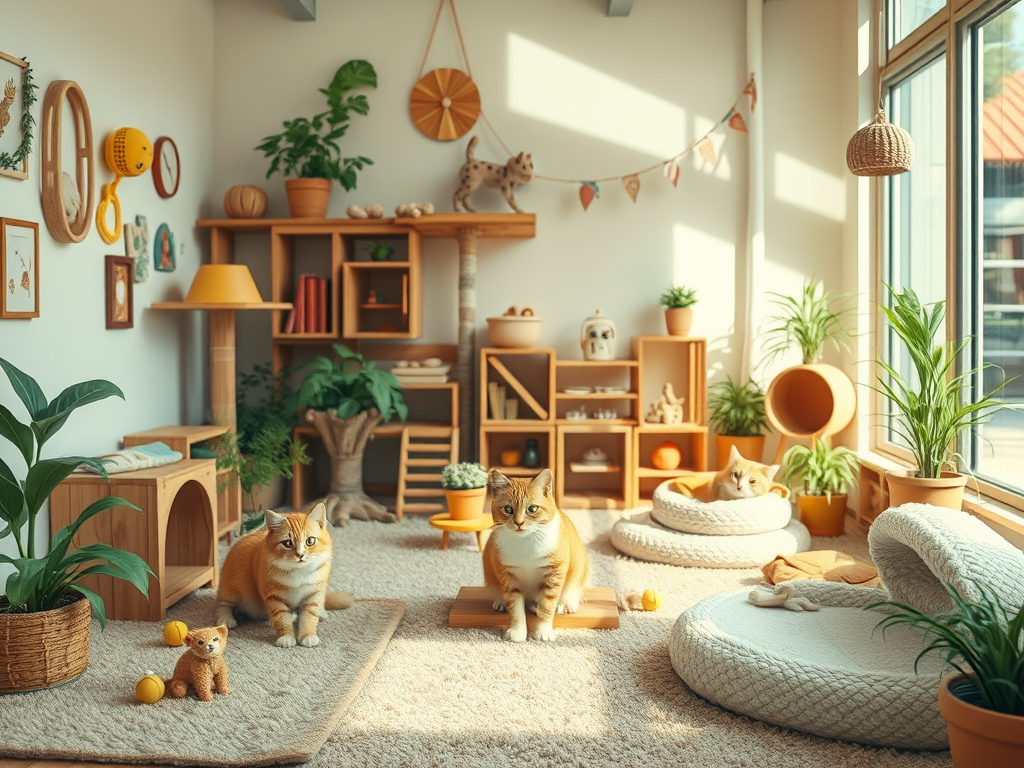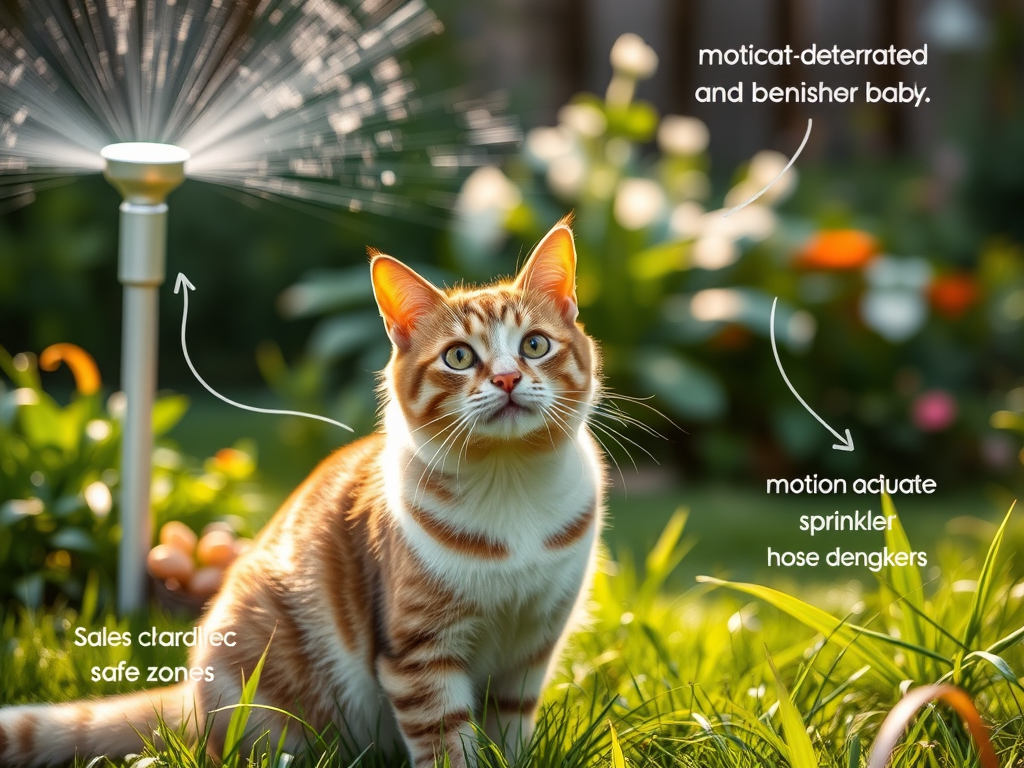Effective Strategies to Reduce Your Cat's Hunting Behavior and Protect Wildlife
Reducing Your Cat's Hunting Impact: Cats are naturally driven to hunt, a behavior deeply embedded in their genetic lineage. To mitigate this instinct while still nurturing it, create a secure indoor environment that stimulates their senses and instincts. By establishing engaging spaces and activities, you can keep your feline companion mentally and physically satisfied without posing a danger to local wildlife. This proactive approach not only enriches their lives but also fosters a harmonious relationship with the surrounding ecosystem, ensuring both your pet’s happiness and the safety of outdoor creatures.
Incorporating interactive toys into your cat's playtime can greatly improve their indoor hunting experience. Toys like feather wands, laser pointers, and motorized mice can engage your cat for extended periods, mimicking the behaviors they would exhibit while hunting. This not only provides essential mental stimulation but also physical exercise, helping your cat expend their energy constructively. By choosing engaging toys, you ensure that your cat remains entertained and satisfied, reducing the likelihood of them seeking out real prey outdoors.
Transform your living space into a thrilling feline playground by setting up obstacle courses filled with boxes, tunnels, and shelves. This mini-jungle gym encourages your cat to explore, climb, jump, and investigate their surroundings. Cats are inherently curious, and by providing them with diverse environments to explore, you can mimic their wild instincts, allowing them to embark on imaginative adventures right in your home. This enrichment is crucial for their mental well-being and overall happiness.
Don’t overlook the benefits of puzzle feeders. These clever devices not only stimulate your cat's mind but also replicate the effort they would expend while hunting. By integrating treat-dispensing puzzles into your cat's feeding routine, you can keep their minds sharp while providing a fun and rewarding experience. This method not only entertains your pet but also encourages healthier eating habits, as they learn to work for their rewards, channeling their natural instincts in a safe manner.
Prioritize playtime as a vital component of your cat's daily routine. Engaging in social interaction through play is essential for strengthening the bond between you and your cat. Make it a habit to schedule regular play sessions, using the toys they enjoy during solo play. This shared engagement alleviates any pent-up frustration your cat may experience and deepens your connection, transforming playtime into a rewarding and fulfilling experience for both of you.
Crafting a stimulating indoor environment for your cat is entirely achievable with creativity and commitment. Your home can become an adventurous landscape that satisfies their natural hunting instincts while keeping them shielded from external dangers. With thoughtful planning, you can cultivate a happy, fulfilled indoor cat that thrives in their safe haven.

Leash Training: Discover New Adventures for Your Cat
Implementing leash training can unlock a realm of safe exploration for your cat. While walks are typically associated with dogs, cats can also enjoy outdoor adventures when trained properly and with patience. By introducing your feline companion to a harness and leash, you can give them the chance to experience the great outdoors while remaining secure and safe.
Start the leash training journey with a comfortable, snug-fitting harness designed for your cat. Allow your pet to become familiar with the harness by letting them sniff and inspect it before putting it on. This gradual introduction helps reduce any anxiety they may feel, fostering positive associations and easing the process. Taking your time with this step will lay the groundwork for successful leash training.
Once your cat feels comfortable with the harness, attach a lightweight leash and practice walking indoors. This familiar setting will help your cat adjust to the feeling of the leash while building their confidence. Be patient, as they may initially resist; remember that acclimating to this new experience requires time and understanding from you as their owner.
When taking your cat outside for the first time, select a calm and safe area, such as your backyard or a quiet park. Ensure the location has minimal traffic and distractions to help your cat feel secure. Begin with brief outdoor sessions to prevent overwhelming your pet, gradually increasing the duration as they become more comfortable in their new environment.
Supervised outdoor time enhances your cat's quality of life, allowing them to enjoy the sights, sounds, and scents of nature without endangering local wildlife. Picture the delight on your cat's face as they discover new experiences in a secure setting. This quality bonding time not only enriches their lives but also strengthens your relationship, creating cherished memories together.
Real-life stories from fellow cat owners can serve as motivation. Many have shared their initial doubts about whether their cats would take to leash walking, but through consistency and positive reinforcement, they have successfully expanded their pets' horizons. Celebrate each small victory as a step towards enhancing your cat's outdoor experiences while ensuring their safety.
By incorporating leash training into your cat's routine, you're creating a balance between outdoor enjoyment and wildlife protection. This thoughtful approach allows your cat to explore while fostering a sense of security in their surroundings.
Creating Safe Outdoor Enclosures: The Advantages of Catios
Outdoor cat enclosures, commonly known as catios, offer an excellent solution for adventurous cats who crave outdoor experiences without the inherent risks. These secure spaces allow your feline friends to enjoy the outdoors while ensuring their safety and safeguarding local wildlife.
Whether you choose to build or purchase a catio, you can customize it to fit your available space and budget. Options can vary from simple balcony enclosures to more elaborate backyard constructions. The main focus should be on creating an escape-proof structure, as ensuring your cat's safety is paramount when providing a secure environment.
When designing your catio, think about incorporating multiple levels and cozy hiding spots for your cat. Cats flourish in environments that offer vertical spaces and secluded areas to retreat. By adding platforms, ramps, and hammocks, you can transform a basic enclosure into a stimulating paradise that mirrors their natural habitat, keeping them entertained and engaged.
Enhancing the sensory experience within the catio can also be advantageous. Introduce elements like cat grass, scratching posts, or logs to create a textured and aromatic environment. This sensory enrichment keeps your cat engaged and happy while allowing them to experience the joys of being outdoors in a controlled setting.
Regular maintenance plays a crucial role in ensuring the safety of your catio. Routinely inspect the enclosure for any signs of wear and tear, including the integrity of the mesh, the overall structure, and the locks. Cats are naturally curious and may test the boundaries of their enclosure, so keeping it in good condition is vital for their safety and well-being.
With a catio, your feline friend can bask in the sun, climb, and observe wildlife without posing a danger to local ecosystems. They can enjoy the warmth of the sun and watch birds from the comfort of their outdoor haven, remaining satisfied while ensuring wildlife remains protected.

Proven Behavioral Training Techniques to Reduce Hunting Instincts
Training your cat to reduce hunting behaviors might appear daunting, but with effective techniques, it can be an achievable goal. The first crucial step is understanding their natural instincts and the behaviors that motivate them to hunt, which is essential for implementing effective training strategies.
Utilizing technology can greatly enhance your training efforts. Consider using motion-activated deterrents, like sprinklers or noise-makers, to create boundaries that discourage hunting without disrupting other activities. By strategically zoning your yard into safe areas, you can redirect your cat's focus away from potential prey.
Positive reinforcement is a key aspect of modifying your cat’s behavior. Reward them for non-hunting actions with treats or affection. For example, if your cat responds to your call or refrains from pursuing a potential target, offer them a tasty treat or extra affection. This method encourages them to repeat desirable behaviors while diminishing their instinctive urge to hunt.
Incorporating clicker training can also be an effective strategy. This technique involves associating a distinct sound with positive actions, allowing your cat to learn the connection between their behavior and rewards. By clicking when they exhibit desirable behavior, you reinforce good habits and clarify your expectations.
For tailored support, consider consulting with feline behavior specialists. They can provide personalized advice and insights that address specific challenges, helping you and your cat coexist peacefully while respecting local wildlife.
The goal of deterrents and training is not to punish but to guide your cat toward behaviors that prioritize their safety and the environment. With consistency and patience, you can redirect their instincts, leading to safer outdoor interactions for both your cat and local wildlife.
Nutritional Strategies to Reduce Hunting Drives in Cats
The type of food you provide and the feeding methods you adopt significantly influence your cat's hunting instincts. Interestingly, a well-fed cat may still exhibit hunting behaviors; however, the way you feed them can help mitigate this drive.
Free feeding, where food is available throughout the day, may not be the best approach for all cats. Instead, consider implementing a structured feeding schedule. By establishing consistent mealtimes, your cat may be less inclined to hunt, as they learn to associate food with specific times of the day, thereby reducing the urge to seek out prey.
Interactive feeding strategies can significantly transform your cat's behavior. Using food puzzles or dispensers can mimic the act of hunting, requiring your cat to ‘work' for their meals. This approach not only keeps them mentally and physically stimulated but also channels their energy positively, allowing their natural instincts to manifest safely.
Take note of the nutritional content of their food as well. A diet high in protein and low in carbohydrates aligns better with a cat's natural dietary needs, potentially leading to a decrease in hunting behaviors. Collaborating with a veterinarian to tailor their diet can ensure your cat's nutritional needs are effectively met.
Finally, offering a variety of food types can satisfy their curiosity and appetite for novelty. Alternating between dry kibble, wet food, and raw diets keeps mealtime interesting, reducing the temptation to seek thrills outside of their food bowl.
Feeding strategies extend beyond mere sustenance; they are a powerful tool for managing your cat's behavior. By adjusting how and what you feed them, you can effectively diminish their inclination to hunt while ensuring they remain satisfied and healthy.

Fostering Community Responsibility for Cat Conservation
Cats are delightful companions, and as their caretakers, we have a responsibility to ensure they coexist harmoniously with local wildlife. By embracing community efforts and personal accountability, we can significantly reduce the ecological impact of free-roaming cats.
Getting involved with local conservation groups is an excellent way to stay updated on wildlife-friendly practices. Many communities offer educational workshops for cat owners, discussing the ecological consequences of allowing cats to roam freely and providing solutions to mitigate these effects.
Consider initiating or participating in neighborhood discussions or social media groups that focus on responsible pet ownership. Sharing resources, tips, and experiences can help foster a wildlife-conscious community and create a supportive network for all pet owners.
One proactive approach involves establishing cat-friendly zones within communal gardens or parks. These designated areas can include enclosures or supervised play spaces, ensuring a secure environment for both cats and wildlife. This collaborative effort enhances awareness and promotes positive interactions between pets and nature.
Incorporating family-friendly initiatives, such as sticker campaigns or educational contests for children and teens, can raise awareness about responsible pet ownership and the importance of coexisting with nature.
Lead by example at home by applying the strategies you’ve learned. Whether it’s leash training, constructing catios, or modifying feeding practices, demonstrating your commitment to a harmonious relationship between your cat and the environment can inspire others to follow suit.
By combining individual actions with community initiatives, we can create a supportive network that balances our cats’ needs with ecological stewardship. Together, we can cherish our pets while respecting and protecting the wild spaces around us.
The Article: Minimize Your Cat’s Hunting Impact Appeared First On Unity Pets.
The Article Minimize Hunting Impact of Your Cat Effectively Was Found On https://limitsofstrategy.com

I appreciate the thoughtful approach you’ve taken in addressing an issue that is often overlooked by cat owners: the natural hunting instincts of our feline companions and the collateral impact they can have on local wildlife. While it’s clear that our cats’ predatory behaviors are deeply ingrained, I find it fascinating how our modern lifestyles have largely shifted these natural instincts into environments that may not align with their biological make-up.
The discussion around mitigating a cat’s hunting instinct while maintaining their mental and physical stimulation is an important topic, particularly given the ecological impacts that free-roaming felines can have on local wildlife. It’s interesting to reflect on the balance between indulging a pet’s natural behaviors and taking responsibility for their impact on the environment.